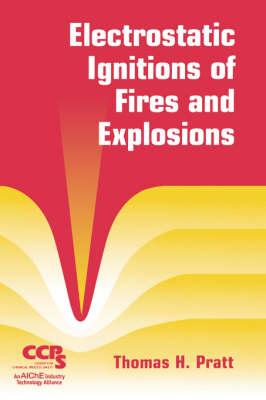
Electrostatic Ignitions of Fires and Explosions
Wiley-AIChE (Verlag)
978-0-8169-9948-4 (ISBN)
Thomas H. Pratt is the author of Electrostatic Ignitions of Fires and Explosions, published by Wiley.
Chapter 1. Basic Concepts. 1.1. The Electrostatic Charge.
1.1.1. Electrons, Protons, and Ions.
1.1.2. Charge Distribution: Point, Space, and Surface Charges.
1.2. The Electric Field.
1.2.1. Mapping Electric Fields.
1.2.2. Dielectrics.
1.2.3. Dielectric Breakdown.
1.3. Ground Potential.
1.3.1. Grounding.
1.3.2. Bonding.
1.4. Requirements for a Fire or an Explosion.
1.4.1. Ignitable Mixture.
1.4.2. Separation.
1.4.3. Accumulation.
1.4.4. Discharge.
Chapter 2. Separation and Accumulation of Charge.
2.1. Mechanisms of Charge Generation.
2.2. Charge Alignment.
2.3. Contact and Frictional Charging.
2.3.1. Surface Charging.
2.3.2. Powder Charging.
2.4. Double Layer Charging.
2.5. Charging of Drops, Mists, and Aerosols.
2.6. Two Phase Flow.
2.7. Charge Separation at Phase Boundaries.
2.8. Charge Relaxation.
2.9. Host Material.
2.9.1. Bulk Conductivity.
2.9.2. Surface Conductivity.
2.9.3. Apparent Conductivity.
2.10. Separation vs. Relaxation.
2.10.1. constant Voltage Case.
2.10.2. Constant Amperage Case.
2.11. Induction.
3. Discharge.
3.1. Classification of Discharges.
3.2. Characteristics of Discharges.
3.2.1. Corona Discharge.
3.2.2. Brush Discharge.
3.2.3. Bulking Brush Discharge.
3.2.4. Propagating Brush Discharge.
3.2.5. Spark or Capacitor Discharge.
3.2.6. Lightning.
Chapter 4. Minimum Ignition Energies.
4.1. Testing of Materials.
4.2. Minimum Ignition Energy, MIE.
4.2.1. MIEs of Gasses and Vapors.
4.2.2. MIEs of Dusts.
4.2.3. MIEs of Hybrid Mixtures.
4.2.4. MIEs in Enriched Oxygen Atmospheres.
4.2.5. MIEs of Explosives.
Chapter 5. Discharge Energies.
5.1. Ignitions by Electrostatic Discharges.
5.2. Capacitive Discharges.
5.2.1. Human Sparks.
5.2.2. Clothing.
5.3. Brush Discharges.
5.3.1. Brush Discharges in Spaces.
5.3.2. Brush Discharges at Surfaces.
5.4. Bulking Brush Discharges.
5.5. Propagating Brush Discharges.
5.6. Corona Discharges.
Chapter 6. Electrification in Industrial Processes.
6.1. Charges in Liquids.
6.1.1. Streaming Currents.
6.1.2. Charge Relaxation in Liquids.
6.1.3. Liquid Conductivity.
6.1.4. Antistatic Additives.
6.1.5. Sedimentation.
6.2. Charges in Mists.
6.2.1. Washing.
6.2.2. Splash Loading.
6.2.3. Steaming.
6.2.4. Carbon Dioxide.
6.2.5. Charge Decay From Mists.
6.3. Charges in Powders.
6.3.1. Streaming Currents in Powders.
6.3.2. Charge Compaction in Powder Bulking.
6.3.3. Charge Relaxation in Powders.
6.4. Surface Charges.
6.4.1. Triboelectric Charging.
6.4.2. Humidity.
6.4.3. Conductive Cloth and Plastics.
6.4.4. Neutralizers.
6.5. Intense Electrification.
6.6. Phase Separation Charges.
7. Design and Operating Criteria.
7.1. Grounding and Bonding.
7.1.1. Insulation from Ground.
7.1.2. Spark Promoters.
7.2. In-Process Relaxation Times.
7.2.1. Quiescent Relaxations.
7.2.2. Relaxation Downstream of Filters.
7.3. Simultaneous Operations.
7.4. Sounding Pipes.
8. Measurements.
8.1. Multimeters.
8.2. Electrometers.
8.3. Electrostatic Voltmeters.
8.4. Fieldmeters.
8.5. Faraday Cage.
8.6. Radios.
9. Quantification of Electrostatic Scenarios.
9.1. Approximations.
9.1.1. Approximating Capacitance.
9.1.2. Approximating Resistance.
9.1.3. Approximating Charge.
9.2. Examples of Approximations.
9.2.1. Refueling an Automobile.
9.2.2. Filling a Gasoline Can.
9.2.3. Flexible Intermediate Bulk Container (FIBC).
9.2.4. The Minimum Capacitor for Incendive Discharge.
Chapter 10. Case Histories.
10.1. Vacuum truck Emptying a Sump.
10.2. Drawing Toluene into an Ungrounded Bucket.
10.3. Sampling while Loading a Railcar.
10.4. Vapor Ignition in a Roadtanker, I.
10.5. Vapor Ignition in a Roadtanker, II.
10.6. Instrumenting a Tank Containing Steam and a Flammable Atmosphere.
10.7. Conductive Liquid in a Plastic Carboy.
10.8. Chemical Hose with an Ungrounded Spiral.
10.9. Three incidents in a Pneumatic Transport System.
10.10. Offloading a Bulk Powder Truck.
10.11. Dumping Powder from a Drum with Metal chime.
10.12. Emptying a Powder from a Plastic Bag (Composite Case History).
10.13. Vapor Explosion in a Closed Tank.
10.14. Gas Well and Pipeline Blowouts.
Appendix A. Units.
Appendix B. Symbols Used in Equations.
Appendix C. Equations.
Appendix D. Atmospheric Electrostatics.
Appendix E. Electric Field Calculations.
Bibliography.
Concordance A, General.
Concordance B, Compounds and Materials.
| Erscheint lt. Verlag | 1.7.1997 |
|---|---|
| Sprache | englisch |
| Maße | 164 x 235 mm |
| Gewicht | 463 g |
| Themenwelt | Naturwissenschaften ► Physik / Astronomie ► Elektrodynamik |
| Technik ► Maschinenbau | |
| ISBN-10 | 0-8169-9948-1 / 0816999481 |
| ISBN-13 | 978-0-8169-9948-4 / 9780816999484 |
| Zustand | Neuware |
| Haben Sie eine Frage zum Produkt? |
aus dem Bereich


